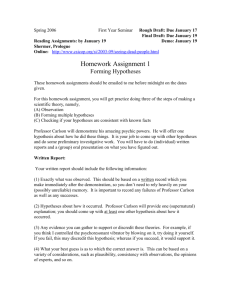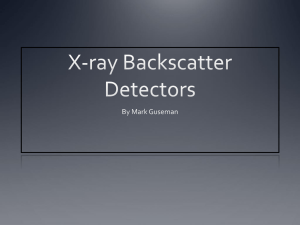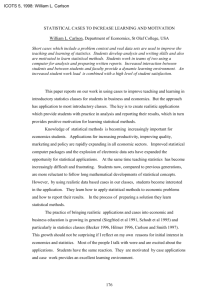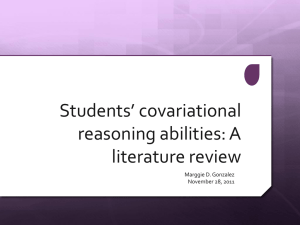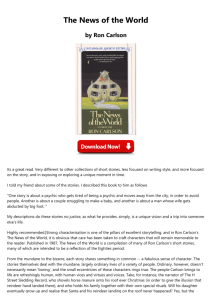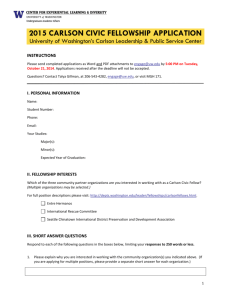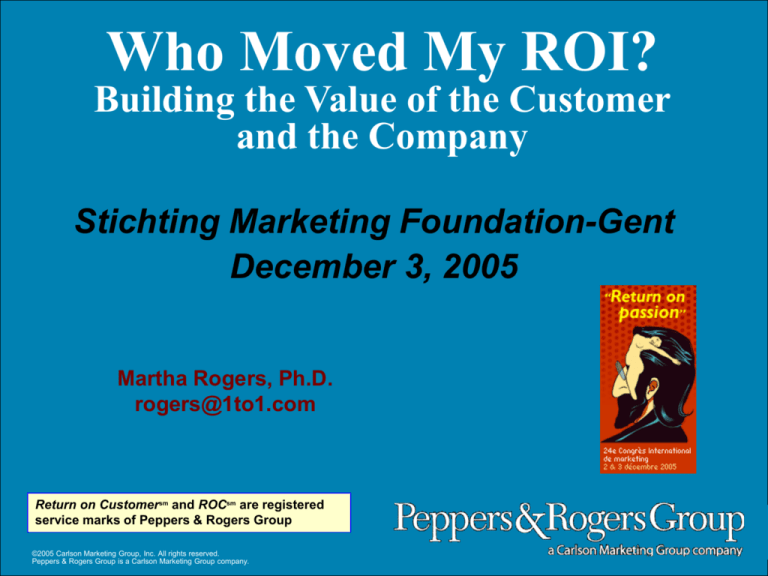
Who Moved My ROI?
Building the Value of the Customer
and the Company
Stichting Marketing Foundation-Gent
December 3, 2005
Martha Rogers, Ph.D.
rogers@1to1.com
Return on Customersm and ROCsm are registered
service marks of Peppers & Rogers Group
©2005 Carlson Marketing Group, Inc. All rights reserved.
Peppers & Rogers Group is a Carlson Marketing Group company.
The “learning relationship”
Save
me
time
Customer talks
with you
FEEDBACK
You tailor your product,
service or interactions
The more effort a customer invests, the greater
his stake in making relationship work
Going to a competitor = reinventing the relationship
©2005 Carlson Marketing Group, Inc. All rights reserved.
Peppers & Rogers Group is a Carlson Marketing Group company.
2
The antithesis to Learning Relationships:
the “Goldfish Principle”
Some species of tropical fish have no capacity
for territorial memory
Businesses operating on the Goldfish Principle
have no customer memories
— One U.S. hotel
©2005 Carlson Marketing Group, Inc. All rights reserved.
Peppers & Rogers Group is a Carlson Marketing Group company.
3
A different dimension of business competition
Maximize the financial return
generated by each customer
Traditional
Return on Customersm
Customer
Needs
Satisfied
Share of
customer
Maximize the financial return
for each product or each
marketing channel
Marketing
Market share
Customers Reached
©2005 Carlson Marketing Group, Inc. All rights reserved.
Peppers & Rogers Group is a Carlson Marketing Group company.
4
Daimler’s prediction of automobile demand
Gottlieb Daimler
World’s first four-wheeled
gasoline-powered automobile
Limiting factor:
A shortage of qualified chauffeurs
©2005 Carlson Marketing Group, Inc. All rights reserved.
Peppers & Rogers Group is a Carlson Marketing Group company.
5
20th Century Marketing
Finding customers for the products available
Today: more products, services, and channels
Limiting factor:
A shortage of paying customers
©2005 Carlson Marketing Group, Inc. All rights reserved.
Peppers & Rogers Group is a Carlson Marketing Group company.
6
Where does all our revenue come from?
From products?
From salespeople?
From our brand?
No, it’s simple –
All our revenue comes from customers
— Fact: Some customers are worth more than others
— Actual and potential value
— Value today and value tomorrow
©2005 Carlson Marketing Group, Inc. All rights reserved.
Peppers & Rogers Group is a Carlson Marketing Group company.
7
Which is harder for a business to produce?
Products? Capital? Or customers?
OK, it’s obvious:
—Customers are more scarce than products or capital
—So why do we keep measuring only the profitability of
products? Why is the return on investment of money
emphasized?
Customers are the limiting factor
You have to maximize the value created by each
customer, not just the value of the financial
investment
©2005 Carlson Marketing Group, Inc. All rights reserved.
Peppers & Rogers Group is a Carlson Marketing Group company.
8
Maximizing enterprise value is similar to farming
Consider good Farmer Wilson
Wilson cultivates his land carefully
©2005 Carlson Marketing Group, Inc. All rights reserved.
Peppers & Rogers Group is a Carlson Marketing Group company.
99
With conservation his land remains productive
It takes money to fertilize, to leave some land fallow, to cultivate in
contours, and to rotate crops
But Wilson’s land will remain productive virtually forever
©2005 Carlson Marketing Group, Inc. All rights reserved.
Peppers & Rogers Group is a Carlson Marketing Group company.
10
10
Contrast with bad Farmer Miller
Miller doesn’t practice conservation
— He simply plants the most profitable cash crop every year,
on every available acre of land
— He saves money by reducing his fertilizer expenditures, and
by avoiding crop rotation
In the beginning, Miller easily harvests
more profit than Wilson does
— But over time his land burns out
©2005 Carlson Marketing Group, Inc. All rights reserved.
Peppers & Rogers Group is a Carlson Marketing Group company.
11
Short-term vs. long-term perspective
Scary thought:
— In any given year, Wilson can always earn more by imitating
Miller, and stopping his conservation
— But that would be stupid, right?
Well, remember the last 4th-quarter meeting?
©2005 Carlson Marketing Group, Inc. All rights reserved.
Peppers & Rogers Group is a Carlson Marketing Group company.
12
Enterprise Creates Value Two Ways
Profits are harvested, and
Customer equity is created or destroyed
Needed: A metric to capture the effects of both
types of value creation
Customers are the scarce resource
So what is the rate at which a company creates
economic value from its customers?
Return on Customer
©2005 Carlson Marketing Group, Inc. All rights reserved.
Peppers & Rogers Group is a Carlson Marketing Group company.
13
What is “Return on Customer”?
Customers are the scarce resource for a business
» ROC measures true economic return on this resource
Consider the ROI on a portfolio of securities
» Tally up dividend and interest income during the period
» Then add in any increases or decreases in the value of the
underlying securities
But what if you only counted the income?
A company is like a portfolio of customers who
» Buy things currently (current-period profit), and
» Go up and down in value (changes in customer equity)
©2005 Carlson Marketing Group, Inc. All rights reserved.
Peppers & Rogers Group is a Carlson Marketing Group company.
14
Excessive focus on the short term
Creates a culture of bad management
— Not only leads to accounting scandals and fraud
— But diverts managers from their primary responsibility:
preserving and increasing the value of the enterprise
Duke University survey of more than 400 senior
financial executives in 2004:
— 78% said their firm would give up economic value if necessary to
meet Wall Street expectations!
Short-term focus distorts how a company views the
value that its customers create for it
©2005 Carlson Marketing Group, Inc. All rights reserved.
Peppers & Rogers Group is a Carlson Marketing Group company.
15
Short-term gain, long-term loss
Highly profitable bank:Market cap in Sept 2004 of $240b
— Japan’s private banking clients generated less than 0.5% of the firm’s net
income – less than $100 million
But then: All the bank’s private banking in Japan was closed by regulatory
authorities and in September Merrill Lynch downgraded the bank’s stock
because: This company “might lack something that poses a threat to its
future growth: a sense of right and wrong.”
Bank’s stock price
was doing well,
and then…
$15 billion of lost value
©2005 Carlson Marketing Group, Inc. All rights reserved.
Peppers & Rogers Group is a Carlson Marketing Group company.
16
ROC increases shareholder return
Best Buy is raising its
“returns on specific
customer segments”
Sept: Rollout announced
May: Pilot test begun
Fortune
July
©2005 Carlson Marketing Group, Inc. All rights reserved.
Peppers & Rogers Group is a Carlson Marketing Group company.
Programs like this result in
Wall Street “rerating the P/E”
17
How Do Customers Create Value?
1. They buy things today, generating current sales and costs
2. They change their likelihood (today) of future buying and
cost generation
Suppose a customer calls you with a complaint...
Or makes a claim after paying for twenty years…
It makes sense for a business to try to increase the value
that any customer creates
This means changing the customer’s behavior
— The company must commit its resources to some
campaign or other marketing (or other) activity
But what “resources” are required?
— We use money, of course, but also customers
©2005 Carlson Marketing Group, Inc. All rights reserved.
Peppers & Rogers Group is a Carlson Marketing Group company.
18
ROC is Similar to ROI
Both money and customers are used by a business
when it creates more value
ROI =
ROC =
Profit from investment + Change in value of investment
Starting value of investment
Profit from customer + Change in value of customer
Starting value of customer
ROI answers the question:
How much value do you get for the money you have to use?
ROC answers the question:
How much value do you get for the customers you have to use?
©2005 Carlson Marketing Group, Inc. All rights reserved.
Peppers & Rogers Group is a Carlson Marketing Group company.
19
Which Resource Will You Run Out of First?
Evaluating two possible
marketing actions
Value of
customer
Investment
required per
customer
Net new value
created per
customer
ROI
ROC
Treatment 1
$100
$10
$30
300%
30%
Treatment 2
$100
$40
$100
250%
100%
If cash
is scarce
If customers
are scarce
Cash available
Customers
affected
Net new value
created
Treatment 1
$5,000,000
500,000
$15,000,000
Treatment 2
$5,000,000
125,000
$12,500,000
Treatment 1
Treatment 2
©2005 Carlson Marketing Group, Inc. All rights reserved.
Peppers & Rogers Group is a Carlson Marketing Group company.
Customers
available
Investment
required
Net new value
created
300,000
300,000
$3,000,000
$12,000,000
$9,000,000
$30,000,000
20
ROI and ROC – Both measures together
Every possible treatment permutation
Maximum ROI
Increasing ROI
Highest value
creation
ROI “hurdle rate”
Maximum ROC
Increasing ROC
©2005 Carlson Marketing Group, Inc. All rights reserved.
Peppers & Rogers Group is a Carlson Marketing Group company.
21
Warning: “Marketing”
can destroy value!
Example: Start with a million customers
A marketing campaign generates a 1% response (10,000)
— Cost is €1 per solicitation, or €1 million total
— Each response generates €125 in LTV profit, or €1.25 million total
— So each individual campaign is successful, with a €250,000 profit
But suppose non-responders become just 0.5% less likely
to respond with each solicitation
Then with each campaign customer equity decreases
by more than the “profit” harvested!
©2005 Carlson Marketing Group, Inc. All rights reserved.
Peppers & Rogers Group is a Carlson Marketing Group company.
22
What do you mean – “use customers”?
Destroy equity by making money now at the expense
of money later
— Reduce the likelihood of future business
— Forfeit all chance of future business from one customer to make money
from another
The DVD rental store fiasco that happens a million
times a day
Scenario: Insurance agent as gatekeeper
©2005 Carlson Marketing Group, Inc. All rights reserved.
Peppers & Rogers Group is a Carlson Marketing Group company.
23
The agent who cost money with every sale
Company Y sells auto, property, health and life insurance
Agents recruit customers, then are protected from
poaching by other Company Y agents
Life and health are far more profitable lines
But this agent does a terrific job winning new customers
for auto insurance...
How much value does
Company Y lose every time
this agent recruits a new
auto customer?
©2005 Carlson Marketing Group, Inc. All rights reserved.
Peppers & Rogers Group is a Carlson Marketing Group company.
24
ROC in Practice
Verizon’s wireless division generated $13.7 billion in operating
earnings from 2002 to 2004 (Owned by Verizon
Communications and Vodaphone)
But during this period the firm also cut monthly customer churn
in half, from 2.6% to 1.3%
Cutting churn required balancing immediate profit against longterm customer satisfaction
Verizon created an additional $10.4 billion of value, in the form
of increased customer LTV!
Average ROC during the period:
©2005 Carlson Marketing Group, Inc. All rights reserved.
Peppers & Rogers Group is a Carlson Marketing Group company.
25
64%
Thinking about future customer buying...
Customers have lifetime values
— Lifetime value (LTV) is simply today’s value of all future profits you predict you’ll get
from a customer
When a customer’s likely future profits change, his LTV changes, also
The amount of the LTV change represents value created (or destroyed),
right now
— Tracking LTV is important, but
— Measuring ROC means tracking changes in LTV
If a firm uses ROI alone, it might:
— Miss the biggest opportunities to create value, or
— Unknowingly destroy more value than it is creating
To understand the total value created by customers, it’s necessary
to measure changes in lifetime value
Tracking ROC is the best and most direct way to
Create maximum value for each customer
©2005 Carlson Marketing Group, Inc. All rights reserved.
Peppers & Rogers Group is a Carlson Marketing Group company.
26
What if we could, and did,
measure how much today’s
decisions really cost?
What if salespeople, service reps, account
managers, and CEOs were penalized for the
customer equity they have to spend today to achieve
this quarter’s revenues?
What if Wall Street analysts held companies
accountable for customer equity (as the best
measure of enterprise value) as well as current
revenue?
©2005 Carlson Marketing Group, Inc. All rights reserved.
Peppers & Rogers Group is a Carlson Marketing Group company.
27
How do we build a customer’s value to us?
We become more relevant
So how do we do that?
We figure out a customer’s needs and meet
those needs better than a competitor who doesn’t
know what we know
Anticipate what customer needs
Take the customer’s point of view:
—Tesco, Orica, Eneco, SPAR, ING Europe
©2005 Carlson Marketing Group, Inc. All rights reserved.
Peppers & Rogers Group is a Carlson Marketing Group company.
28
Why do so many customer initiatives fail?
The information problem
— Understand the whole value and need of each customer
— Across products, services, geographies, touchpoints, and time
The strategy problem
— Ready, fire, aim!
— Do our customers belong to “marketing,” or are they the only
source of revenue for our company?
— How do we measure the rate at which customers create value for
our company? How do we report it?
— Who’s accountable for that? How do we manage it?
The adoption problem
— Every employee decision and action creates or destroys value.
How do we build the ROC philosophy into everyone’s DNA?
©2005 Carlson Marketing Group, Inc. All rights reserved.
Peppers & Rogers Group is a Carlson Marketing Group company.
29
Managing a firm’s “Customer Equity”
ROC means making a lot of marketing
decisions, as well as non-marketing
decisions, about how we do our job
Every management
decision should be
made with an eye toward
its impact on customer
equity
©2005 Carlson Marketing Group, Inc. All rights reserved.
Peppers & Rogers Group is a Carlson Marketing Group company.
30
Taking the customer’s point of view means:
Treat Different
Customers
Differently
Relationships built on trust are the vehicle for
customer-specific actions
©2005 Carlson Marketing Group, Inc. All rights reserved.
Peppers & Rogers Group is a Carlson Marketing Group company.
31
ROC has two equally important aspects
An economic metric for calculating the rate at
which customers create value
— Calculating the real costs of abusive marketing
— Financial justification for a better customer experience,
higher satisfaction, loyalty, etc.
A philosophy of doing business based on earning
customers’ trust
— Maximizing the value customers create requires
— Maximizing the value created for customers
©2005 Carlson Marketing Group, Inc. All rights reserved.
Peppers & Rogers Group is a Carlson Marketing Group company.
32
Creating a culture of customer trust
“Treat the customer the way you would want to be
treated if you were the customer.”
“No one tries harder for customers.”
“Our goal with our Fair Play program is to
make ethics a natural part of our business”
©2005 Carlson Marketing Group, Inc. All rights reserved.
Peppers & Rogers Group is a Carlson Marketing Group company.
33
Stena empowers its employees…
Irish Sea routes – 3mm+ passengers annually, for years it had a fairly
bad service reputation
Today virtually 100% of passengers are asked about their satisfaction
within 30 minutes of destination
— Different Stena staff inquire, try to resolve problems on the spot
Everyone on staff – all 600 people – anyone can elect to spend up to
£1000 to satisfy a customer!
©2005 Carlson Marketing Group, Inc. All rights reserved.
Peppers & Rogers Group is a Carlson Marketing Group company.
34
Creating a culture of customer trust
These companies are not just selling
something.
They are building the value of the
customer base.
©2005 Carlson Marketing Group, Inc. All rights reserved.
Peppers & Rogers Group is a Carlson Marketing Group company.
35
Return on Customer: Six rules
First rule of ROC:
Return on Customer = Total Shareholder Return
Customer equity equals enterprise value for an
operating company
©2005 Carlson Marketing Group, Inc. All rights reserved.
Peppers & Rogers Group is a Carlson Marketing Group company.
36
Return on Customer: Six rules
Second rule of ROC:
Both long-term and short-term must be balanced
Don’t ignore the importance of short-term earnings!
©2005 Carlson Marketing Group, Inc. All rights reserved.
Peppers & Rogers Group is a Carlson Marketing Group company.
37
Return on Customer: Six rules
Third rule of ROC:
LTV is important, but LTV change
is the number you actually want
You need to identify the “leading indicators”
LTV change
©2005 Carlson Marketing Group, Inc. All rights reserved.
Peppers & Rogers Group is a Carlson Marketing Group company.
38
of
Return on Customer: Six rules
Fourth rule of ROC:
Think and act in a customer-specific way
Customer relationships are required to
maximize Return on Customer
©2005 Carlson Marketing Group, Inc. All rights reserved.
Peppers & Rogers Group is a Carlson Marketing Group company.
39
Return on Customer: Six rules
Fifth rule of ROC:
Earn the trust of your customers
Customers don’t care about their value to you;
they only care about what they need from you
©2005 Carlson Marketing Group, Inc. All rights reserved.
Peppers & Rogers Group is a Carlson Marketing Group company.
40
Return on Customer: Six rules
Sixth rule of ROC:
Educate your employees and empower them to take
action
Everyone has a different role to play, but the ROC metric
provides a unifying objective for the whole organization.
It’s everyone’s job to increase ROC.
©2005 Carlson Marketing Group, Inc. All rights reserved.
Peppers & Rogers Group is a Carlson Marketing Group company.
41
Peppers & Rogers Group
www.1to1.com
Speaking, media, strategic consulting and
thought leadership focused on building
enterprise value through the customer
issues
Now the strategic consulting arm of
Carlson Companies, Minneapolis
Magazines, newsletters, white papers
www.1to1.com
www.returnoncustomer.com
rogers@1to1.com
©2005 Carlson Marketing Group, Inc. All rights reserved.
Peppers & Rogers Group is a Carlson Marketing Group company.
42
Toyama no Kusuri-Uri
House-to-house medical supplies
Consumers only charged for usage
Detailed records kept in a database, called the
“Daifuku cho”
Circa 1750
©2005 Carlson Marketing Group, Inc. All rights reserved.
Peppers & Rogers Group is a Carlson Marketing Group company.
43
Peppers and Rogers Group
Carlson Marketing Group
www.1to1.com
©2005 Carlson Marketing Group, Inc. All rights reserved.
Peppers & Rogers Group is a Carlson Marketing Group company.
44
www.1to1.com
www.returnoncustomer.com
©2005 Carlson Marketing Group, Inc. All rights reserved.
Peppers & Rogers Group is a Carlson Marketing Group company.
45
www.1to1.com
www.returnoncustomer.com
©2005 Carlson Marketing Group, Inc. All rights reserved.
Peppers & Rogers Group is a Carlson Marketing Group company.
46
www.1to1.com
www.returnoncustomer.com
©2005 Carlson Marketing Group, Inc. All rights reserved.
Peppers & Rogers Group is a Carlson Marketing Group company.
47
www.1to1.com
www.returnoncustomer.com
©2005 Carlson Marketing Group, Inc. All rights reserved.
Peppers & Rogers Group is a Carlson Marketing Group company.
48

